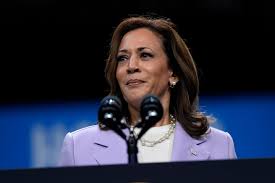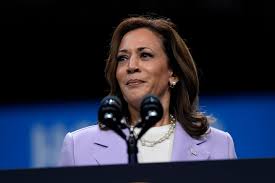As the 2024 presidential race intensifies, Vice President Kamala Harris has strategically focused her campaign messaging on one of the most pressing concerns for American voters: high food prices. Inflation, a key issue affecting many aspects of daily life, has become a focal point in the current election cycle, and Harris’s emphasis on the high cost of food reflects both the gravity of the issue and her campaign’s strategic positioning.
Table of Contents
The Inflation Landscape
Inflation has been a significant economic challenge in the United States, with its effects being felt across a broad spectrum of goods and services. Over the past year, rising prices have hit consumers hard, particularly in the grocery aisles where the cost of everyday food items has surged. This inflationary pressure has been driven by several factors, including supply chain disruptions, increased production costs, and broader economic uncertainties.
Food prices, in particular, have been a point of contention and concern for many Americans. The U.S. Department of Agriculture has reported consistent increases in food costs, which have outpaced wage growth for many households. This has led to heightened scrutiny from both the public and politicians, with many viewing the issue as a direct reflection of economic management and policy effectiveness.
Harris’s Focus on Food Prices
Vice President Kamala Harris’s decision to spotlight high food prices comes as part of a broader strategy to address inflation and connect with voters who are feeling the pinch. Her approach reflects an understanding of the critical role that cost-of-living issues play in shaping voter sentiment and election outcomes.
**1. Campaign Messaging: Harris has framed high food prices as a direct consequence of inflationary pressures that need immediate and effective government intervention. By zeroing in on this issue, she aims to highlight her commitment to addressing the economic struggles faced by everyday Americans.
**2. Policy Proposals: Harris has proposed several initiatives aimed at alleviating the burden of high food prices. These proposals include:
- Support for Local Farmers: Advocating for increased support for local agriculture and sustainable farming practices to boost supply and stabilize prices.
- Expansion of Food Assistance Programs: Proposing enhancements to food assistance programs like SNAP (Supplemental Nutrition Assistance Program) to provide greater relief to low-income families.
- Price Regulation Measures: Supporting regulatory measures to ensure fair pricing practices and reduce the impact of price gouging in the food sector.
**3. Public Engagement: Harris has engaged with communities across the country to discuss the impact of high food prices and gather input on how best to address the issue. These engagements include town hall meetings, community forums, and media appearances.
Political Implications and Strategy
Harris’s emphasis on high food prices and inflation serves several strategic purposes in the context of the presidential race:
**1. Addressing Voter Concerns: High food prices are a tangible issue that affects a broad range of voters, making it a powerful topic for Harris to address. By focusing on this issue, she aims to resonate with voters who are directly experiencing the financial strain of rising food costs.
**2. Differentiating Her Campaign: In a crowded field of presidential candidates, Harris’s focus on specific economic issues like food prices helps differentiate her from her competitors. It allows her to carve out a distinct position on economic policy and present herself as a candidate who understands and is committed to addressing immediate economic challenges.
**3. Building Momentum: Addressing high food prices also provides an opportunity for Harris to build momentum and gain traction in the polls. By demonstrating a proactive approach to a critical issue, she aims to enhance her appeal to undecided voters and strengthen her campaign’s overall positioning.
Challenges and Criticisms
While Harris’s focus on high food prices has been well-received by many, it also comes with its share of challenges and criticisms:
**1. Implementation Feasibility: Critics argue that some of Harris’s proposed solutions may face challenges in implementation. For instance, expanding food assistance programs and supporting local farmers require significant policy changes and funding, which may encounter legislative and logistical hurdles.
**2. Broader Economic Impact: Addressing food prices is just one aspect of the broader inflation issue. Some critics argue that focusing solely on food costs may not fully address the broader economic factors driving inflation and may not provide a comprehensive solution to the overall cost-of-living crisis.
**3. Political Repercussions: As with any high-profile campaign issue, there is the potential for backlash from opponents who may criticize Harris’s proposals or question her effectiveness in addressing the problem. Her campaign will need to navigate these criticisms and effectively communicate the value of her proposed solutions.
Broader Implications for the Presidential Race
Harris’s focus on high food prices and inflation has broader implications for the presidential race:
**1. Electoral Strategy: How effectively Harris can leverage the issue of high food prices will play a crucial role in her electoral strategy. Success in this area could boost her standing in key battleground states and influence the overall outcome of the race.
**2. Policy Debate: The emphasis on food prices and inflation is likely to shape the broader policy debate in the presidential race. It will prompt other candidates to articulate their positions on economic issues and provide a platform for discussing various approaches to managing inflation.
**3. Voter Priorities: The focus on high food prices highlights the importance of economic issues in the current political climate. It underscores the need for candidates to address voter concerns about the cost of living and present concrete plans for economic relief.
Looking Ahead
As the presidential race continues, Harris’s focus on high food prices will be a key area to watch. The effectiveness of her campaign messaging and the reception of her proposed solutions will influence her prospects and the overall dynamics of the race.
**1. Policy Development: Harris’s campaign will need to continue refining and developing its policy proposals to address high food prices and broader inflationary pressures. This will involve working with legislators, stakeholders, and experts to ensure that her solutions are feasible and impactful.
**2. Public Communication: Effective communication with the public will be essential for Harris to maintain momentum and build support. This includes addressing concerns, clarifying policy proposals, and engaging with voters on their economic challenges.
**3. Campaign Strategy: The focus on food prices will be a critical component of Harris’s campaign strategy. Her ability to navigate the complexities of this issue and integrate it into a broader economic platform will be key to her success in the race.

Conclusion
Vice President Kamala Harris’s strategic focus on high food prices as part of her presidential campaign underscores the significance of inflation and cost-of-living issues in the current political climate. By addressing the impact of rising food costs and proposing targeted solutions, Harris aims to connect with voters, differentiate her campaign, and build momentum in the race. As the election progresses, the effectiveness of her approach and the broader implications for the presidential race will be closely watched.








